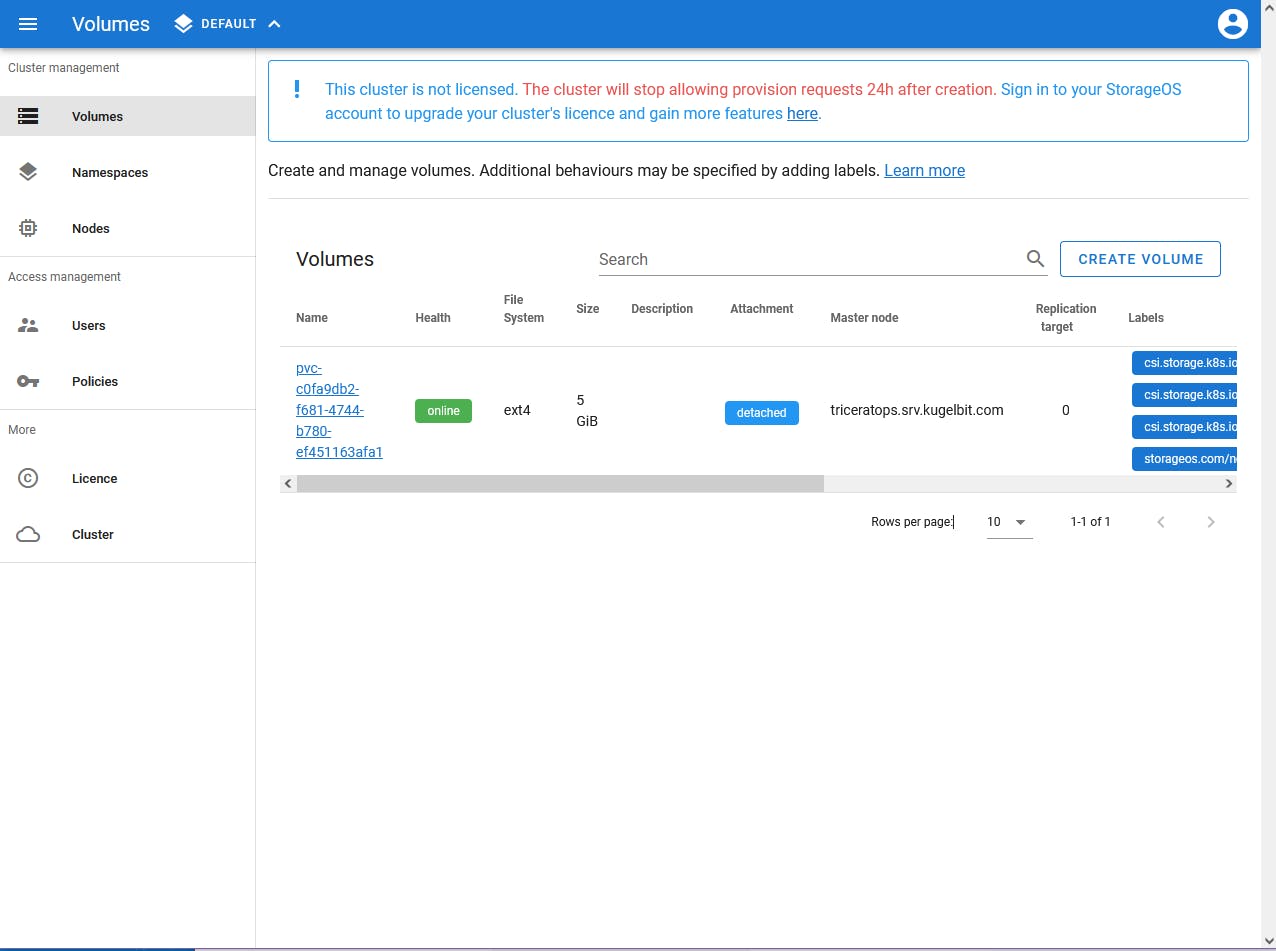Installing k8s storage with Ondat
In this tutorial we will walk thought installation of persistent storage in kubernetes with OnDat (Storage OS) product.
Fist why Ondat? There are other free alternatives like rook or paid ones like Portworx
My main reason to use OnDat is because of a limitation in the VPS host. It can't provide separate storage disks. That is a requirement in solutions like rook and portworx.
Because of that limitation I almost switch of VPS provider from contabo to hetzner.
Using another provider like hetzner could be a better alternative because it has native integration with its cloud storage system, that way we don't need to worry about it and can be more performatic since communication between host and storage could be in a internal network.
Ondat is a good alternative for on promise cluster, and after some evaluation I decide to stick with it. It has a free license for 1TiB storage in cluster. For now this is plenty for my use case, but it can be expansive if you need more resources.
Take a look at Ondat https://docs.ondat.io/docs/prerequisites/ and https://docs.ondat.io/docs/best-practices/ and judge by yourself if is a good solution for you.
We will use the same master nodes as etcd nodes for OnDat. Your cluster has 3 master, etcd, and worker nodes, this could be a limiting point for a more performatic cluster, for instance you could separate the masters, etcd from the workers, if the cluster grows I think it should be a better solution this separation.
Now lets begin, all steps here are documented in https://docs.ondat.io/docs/prerequisites/ and https://docs.ondat.io/docs/install/
Pre-requisites
First we need the kernel modules loaded, we are using Ubuntu Server 20.04 LTS
For this you could use a ansible playbook for automation, make sure ansible is installed on your system (Linux or WSL Windows, Or Mac)
git clone git@gitlab.com:gcsilva/ondat-playbook.git
cd ondat-playbook
Edit the inventory/hosts.yml file and add your hosts ips or dns names.
Also make sure you can ssh without a password using just ssh keys in the systems. For this follow this tutorial https://phoenixnap.com/kb/ssh-with-key
Now run the playbook
ansible-playbook -i inventories/contabo/ playbooks/ondat.yml
If you get some error of a the role not being found, link the role folder in the playbook folder:
cd playbooks
ln -s ../roles .
Run the playbook again.
Installing ETCD
We will use ansible to install etcd.
First clone the playbooks:
git clone https://github.com/storageos/deploy.git
cd k8s/deploy-storageos/etcd-helpers/etcd-ansible-systemd
Edit the file hosts put the external ssh hosts and in the ip put the internal VPN ips. (if you follow my other post about k8s cluster in contabo we setup a private VPN)
The host should be something like
[nodes]
host1.srv.yourdomain.com ansible_user=root ip="10.8.0.1" fqdn="10.8.0.1"
host2.srv.yourdomain.com ansible_user=root ip="10.8.0.2" fqdn="10.8.0.2"
host3.srv.yourdomain.com ansible_user=root ip="10.8.0.3" fqdn="10.8.0.3"
If you client machine is on the same VPN as the servers you could use their private ips as the host
Now edit the installation configuration in group_vars/all
We need to change etcd_port_client and etcd_port_peers to something that do not colide with the etcd running on the masters for kubernetes, my is 2381 and 2382 respectively
Also change advertise_format to ip, and disable the tls tls: enabled: false. We are not using tls because it complicates a little bit the deployment of storage because you will need the certificates, and we are using an encrypted VPN anyway
Now install etcd
ansible-playbook -i hosts install.yaml
Installing OnDat
Install ondat cluster operator
kubectl create -f https://github.com/storageos/cluster-operator/releases/download/v2.4.4/storageos-operator.yaml
Create ta secret for the passwords
apiVersion: v1
kind: Secret
metadata:
name: "storageos-api"
namespace: "storageos-operator"
labels:
app: "storageos"
type: "kubernetes.io/storageos"
data:
# echo -n '<secret>' | base64
apiUsername: c3RvcmFnZW9z
apiPassword: c3RvcmFnZW9z
# CSI Credentials
csiProvisionUsername: c3RvcmFnZW9z
csiProvisionPassword: c3RvcmFnZW9z
csiControllerPublishUsername: c3RvcmFnZW9z
csiControllerPublishPassword: c3RvcmFnZW9z
csiNodePublishUsername: c3RvcmFnZW9z
csiNodePublishPassword: c3RvcmFnZW9z
csiControllerExpandUsername: c3RvcmFnZW9z
csiControllerExpandPassword: c3RvcmFnZW9z
Change the username and password with something you generate with the command:
echo -n 'user' | base64
echo -n 'secret' | base64
Now create a svc pointing to your external etcd cluster
kubectl create namespace storageos-etcd
Apply the yamls:
apiVersion: v1
kind: Endpoints
metadata:
name: storageos-etcd
namespace: storageos-etcd
labels:
app: etcd
cluster: storageos
subsets:
- addresses:
- ip: 10.1.10.216
- ip: 10.1.10.217
- ip: 10.1.10.218
ports:
- name: client
port: 2381
protocol: TCP
apiVersion: v1
kind: Service
metadata:
name: storageos-etcd
namespace: storageos-etcd
labels:
app: etcd
cluster: storageos
spec:
clusterIP: None
ports:
- name: client
port: 2381
targetPort: 2381
selector: null
Label all the nodes you want be part of the cluster:
kubectl label nodes node1 ondat/storage=true # repeat for all nodes
Now create the cluster apply the follow yaml:
apiVersion: "storageos.com/v1"
kind: StorageOSCluster
metadata:
name: "ondat"
namespace: "storageos-operator"
spec:
# Ondat Pods are in kube-system by default
secretRefName: "storageos-api" # Reference from the Secret created in the previous step
secretRefNamespace: "storageos-operator" # Namespace of the Secret
k8sDistro: "upstream"
images:
nodeContainer: "storageos/node:v2.4.4" # Ondat version
kvBackend:
address: 'storageos-etcd.storageos-etcd:2381' # Example address, change for your etcd endpoint
# address: '10.42.15.23:2379,10.42.12.22:2379,10.42.13.16:2379' # You can set ETCD server ips
resources:
requests:
memory: "512Mi"
cpu: 1
nodeSelectorTerms:
- matchExpressions:
- key: "ondat/storage"
operator: In
values:
- "true"
Check your cluster health:
kubectl -n kube-system get pods
The pods storageos-daemonset most be running
Lets login in the management ui
kubectl port-forward -n kube-system svc/storageos 5705
Browser to http://localhost:5705
Login with the username and password you choose on the secret.
Lets test the cluster:
git clone https://github.com/storageos/use-cases.git
cd use-cases/00-basics
kubectl apply -f pvc-basic.yaml
kubectl apply -f pod.yaml
kubectl apply -f pod.yaml
kubectl exec -it d1 -- bash
echo 'hello' > /mnt/helloworld.txt
exit
kubeclt delete pod d1 # kill the pod
kubectl apply -f pod.yml
kubectl exec -it d1 -- bash
cat /mnt/helloworld.txt # content are preserved
You should see the volume in ondat ui:

Now you need to register your cluster, follow the steps in https://docs.ondat.io/docs/operations/licensing/ to do it.
Your cluster is up! You can create new storage classes with different replication factors or encrypted volumes as well.
